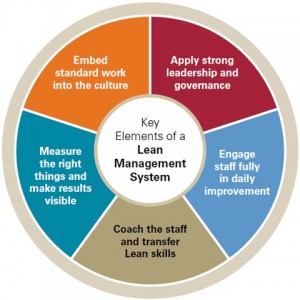 Lean is about streamlining processes and Six Sigma is about reducing defects. The Lean Six Sigma methodology is therefore a way of accelerating Six Sigma by streamlining the process while reducing defects. Lean Six Sigma is applicable to all kinds of organizations including not-for-profit organizations and can produce remarkable benefits in productivity, revenue, profitability as well as customer satisfaction. Here are some key principles of Lean Six Sigma…
Lean is about streamlining processes and Six Sigma is about reducing defects. The Lean Six Sigma methodology is therefore a way of accelerating Six Sigma by streamlining the process while reducing defects. Lean Six Sigma is applicable to all kinds of organizations including not-for-profit organizations and can produce remarkable benefits in productivity, revenue, profitability as well as customer satisfaction. Here are some key principles of Lean Six Sigma…
Tag: lean management
 Lean management began as an effort at Toyota to reduce time for a manufacturing process and thus reduce in-process inventory. This became known as just-in-time inventory management. The result was less warehouse space, fewer forklifts, less workshop space, etc. Once the flow of work can be free of interruption and unnecessary repeat work, waste is eliminated. Lean is therefore the elimination of waste. But, more importantly, lean is continuous improvement in all work processes…
Lean management began as an effort at Toyota to reduce time for a manufacturing process and thus reduce in-process inventory. This became known as just-in-time inventory management. The result was less warehouse space, fewer forklifts, less workshop space, etc. Once the flow of work can be free of interruption and unnecessary repeat work, waste is eliminated. Lean is therefore the elimination of waste. But, more importantly, lean is continuous improvement in all work processes…
Based on an extract from a Business Insider web article. The original article was written by Alison Griswold and Vivian Giang.
 Smart and successful entrepreneurs including the likes of Richard Branson of Virgin and Tony Hsieh of Zappos know that interview questions like “What’s your biggest strength?” and “What’s your biggest weakness?” don’t produce revealing answers. That’s why they steer clear of these cliché queries and instead ask more meaningful ones. Many executives have their one favorite go-to question that reveals everything they need to know about a job candidate. Here is a list of the top 10 questions…
Smart and successful entrepreneurs including the likes of Richard Branson of Virgin and Tony Hsieh of Zappos know that interview questions like “What’s your biggest strength?” and “What’s your biggest weakness?” don’t produce revealing answers. That’s why they steer clear of these cliché queries and instead ask more meaningful ones. Many executives have their one favorite go-to question that reveals everything they need to know about a job candidate. Here is a list of the top 10 questions…
The SCARF Model was originally proposed by David Rock of the Neuro-Leadership Institute and has been acclaimed as one of the best and original ideas in management over the last 15 years.
 In a world of increasing inter-connectedness and rapid change, there is a growing need to improve the way people work together. The study of the brain is starting to provide some key insights that can be applied in the real world – for example in the work place. Social neuroscience explores the biological foundations of the way humans relate to each other and to themselves in terms of emotional regulation, attitudes, stereotyping, empathy, status, fairness, collaboration, persuasion, morality, compassion, deception and trust…
In a world of increasing inter-connectedness and rapid change, there is a growing need to improve the way people work together. The study of the brain is starting to provide some key insights that can be applied in the real world – for example in the work place. Social neuroscience explores the biological foundations of the way humans relate to each other and to themselves in terms of emotional regulation, attitudes, stereotyping, empathy, status, fairness, collaboration, persuasion, morality, compassion, deception and trust…
 Lean thinking principles essentially consist of a five-step thought process proposed by Womack and Jones in 1996 to guide managers through a process of lean transformation. Lean thinking is equally applicable in manufacturing (enhancing quality and reducing waste), in entrepreneurial startups where being lean and thinking lean are essential for survival and in large enterprises that have grown to the point where they need to re-think processes and client interfaces. Here are the five principles…
Lean thinking principles essentially consist of a five-step thought process proposed by Womack and Jones in 1996 to guide managers through a process of lean transformation. Lean thinking is equally applicable in manufacturing (enhancing quality and reducing waste), in entrepreneurial startups where being lean and thinking lean are essential for survival and in large enterprises that have grown to the point where they need to re-think processes and client interfaces. Here are the five principles…

Recent Comments